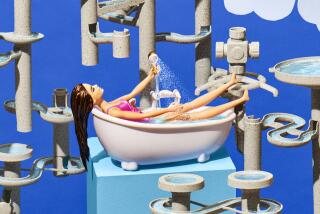A River That Runs in the Center of It All
It was to a park next to the Los Angeles River, where the night air still lingered under the sycamores, that Dan Cooper came to promote his vision Saturday.
His is a hard sell in a city that has so long laid siege to the land on which it grew: Cooper wants to show that the much-maligned river and its many tributaries, in fact, are a living system, binding together all those lonely, withered patches of native vegetation that have survived the onslaught of stucco and tile.
But the eight who gathered to listen were “friends” of the L.A. River. They already knew the word “brush” is an insult to Southern California’s diverse flora, that chaparral is much more than a fire hazard, that in quiet corners of our urban sprawl one still can sit and watch the willows turn silver in the breeze.
What Cooper’s listeners wanted to know was how those corners are connected, and how their great concrete river can be at the center of it all.
So they listened to the 25-year-old graduate student from UC Riverside as he guided a daylong tour of the watercourse, from its headwaters in the steep, wooded canyon of Big Tujunga Creek to its lackluster outflow in Long Beach.
“The thing we’re working on is trying to bring attention to the natural portions that remain,” Cooper said, “to know it’s an intact system, to know that the mouth in Long Beach is no different than here in Burbank or the headwaters in the mountains.”
His vision, of course, encompasses a watercourse less pristine than that which greeted Gaspar de Portola, when he and his soldiers first crossed the basin’s dry sage scrub in 1769. Then, willows and cottonwoods spread out from the braided river. Eagles roosted on the bowing limbs, while steelhead trout spawned in the river’s upper reaches.
Now, one sees much of the river hemmed in by concrete and steel, crossed by railroad tracks and filled with water from a sewage treatment plant.
Cooper just wants a little respect for the waterway and its tributaries, he said, as well as natural, recreational development for the vacant areas that remain around it.
“Obviously, you don’t want to build a forest in downtown Los Angeles,” he said. “No one’s thinking there’s going to be an Eden there. We just want logical restoration of the open spaces.”
At Bette Davis Park in Burbank, where his lesson began at 8 a.m., he sees a decent example of what the river has to offer in an urban environment. The oaks and sycamores provide food and shelter to which native birds are accustomed, as well as a shady, peaceful environment for amblers and dogwalkers.
Though the river is channeled here, the bottom is natural, allowing the native willows to grow and create eddies, where birds can rest on their migratory routes.
With his Bushnell telescope, Cooper pointed out blue and green herons lumbering through the air while great yellowlegs and killdeer scurried in the cattails. The shorebirds see the river as a network of rest stops on the Pacific Flyway, Cooper said.
“They’re on vacation in Burbank today,” he said.
In the riverbed, large granite boulders illustrate how the river brings together isolated parts of the city and county. They catch driftwood and trash that flow from all parts with the extreme ebbs and flows of rainwater. They themselves rolled down from the San Gabriel Mountains, along with willow seeds and the sediment that made the Los Angeles Basin so fertile.
A cottonwood growing in Long Beach may have sprouted from a seed that fell 60 miles away in the Angeles National Forest, Cooper said.
The next stop was upriver at the Hansen Dam in Pacoima, a massive forest of arroyo willows and mulefat, a spreading shrub with spear-shaped leaves. With dragonflies and spider webs glowing in the sunlight, the group explored a part of the watershed less tainted by development.
“It’s so beautiful,” said Martha Yee of Echo Park. “It really broadens your appreciation of the river.”
Then the group proceeded along the windy road up Big Tujunga Canyon. The houses faded as the mountain mahogany and Douglas firs began to appear. Here the river rushed clear in the canyon bottom, a strong glimpse of what once was.
More to Read
Sign up for Essential California
The most important California stories and recommendations in your inbox every morning.
You may occasionally receive promotional content from the Los Angeles Times.










